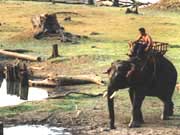 The wild elephants of Vietnam are primarily concentrated in the southern region of the Trường Sơn mountain range, particularly in Đắk Lắk province. However, their numbers have been gradually declining. In 1975, Đắk Lắk had approximately 400 wild and domesticated elephants, but by 1990, that number had dropped to 200, and by the end of this year, only about 60 elephants remain.
The wild elephants of Vietnam are primarily concentrated in the southern region of the Trường Sơn mountain range, particularly in Đắk Lắk province. However, their numbers have been gradually declining. In 1975, Đắk Lắk had approximately 400 wild and domesticated elephants, but by 1990, that number had dropped to 200, and by the end of this year, only about 60 elephants remain.
Vietnamese elephants belong to the Asian elephant species, with only males possessing tusks and being smaller than African elephants. This rare animal is listed in the World Red Data Book and the Vietnam Red Book of 1992 at the highest level of protection. They predominantly inhabit the Đắk Lắk plateau, specifically in the primeval forests along the Chư Yang Sin mountain range (Lăk and Krông Bông districts) and the forest areas extending from Ea Súp district to Buôn Đôn, bordering Cambodia, within the Yok Don National Park.
Đắk Lắk has long been famous for the Ban Don area, home to the M’Nong ethnic community, known for hunting and taming elephants. Many individuals specialized in capturing wild elephants here, with two being honored as elephant kings, such as Ama Thu and Ama Kông, who captured hundreds of elephants from the Yok Don mountains across the Sêrêpôk River.
To protect the rare elephant species of the Central Highlands in Vietnam, the government prohibited hunting wild elephants several years ago. With the new lifestyle and broader exchanges, the local communities have also reduced their demand for taming and using elephants for daily transportation, abandoning the traditional practice of hunting elephants. However, poaching still occurs, along with the shrinking of their natural habitats, leading to a significant decline in this rare species year by year.
In 1997, Đắk Lắk province had only 115 domesticated elephants, while wild elephants were even scarcer, with around 30 remaining. The large Chư Yang Sin mountain range showed almost no signs of wild elephants anymore. By 2000, the number of domesticated elephants dropped to 84, and in 2004, only 62 were left. During this time, wild elephants dwindled to approximately 10-15, moving unsafely around the increasingly sparse forest regions along the Vietnam-Cambodia border in the Ea Súp, Buôn Đôn, and Chư Jút and Đắk Mil districts of the newly formed Đắk Nông province.
By the end of 2005, the elephant population in Đắk Lắk province had declined to fewer than 50 domesticated elephants, while the number of wild elephants was extremely low, especially among the males with tusks, which were being targeted by poachers.
Strict protection and conservation measures for elephants were implemented starting in early 1992, including an urgent directive from the Prime Minister regarding the protection of rare wildlife species, an action plan for elephant conservation implemented by the international organization FFI and the Ministry of Agriculture and Rural Development, and a workshop on Asian elephant conservation in Indochina. These efforts aimed to create suitable habitats for wild elephants in Yok Don National Park and included numerous regulations prohibiting elephant hunting.
However, the risk of complete extinction of elephants in this highland area in the coming years is becoming increasingly evident. Experts indicate that without conservation efforts and the restoration of natural forests to provide a safe and adequate environment for elephants, their chances of recovery and reproduction will be extremely low.


















































